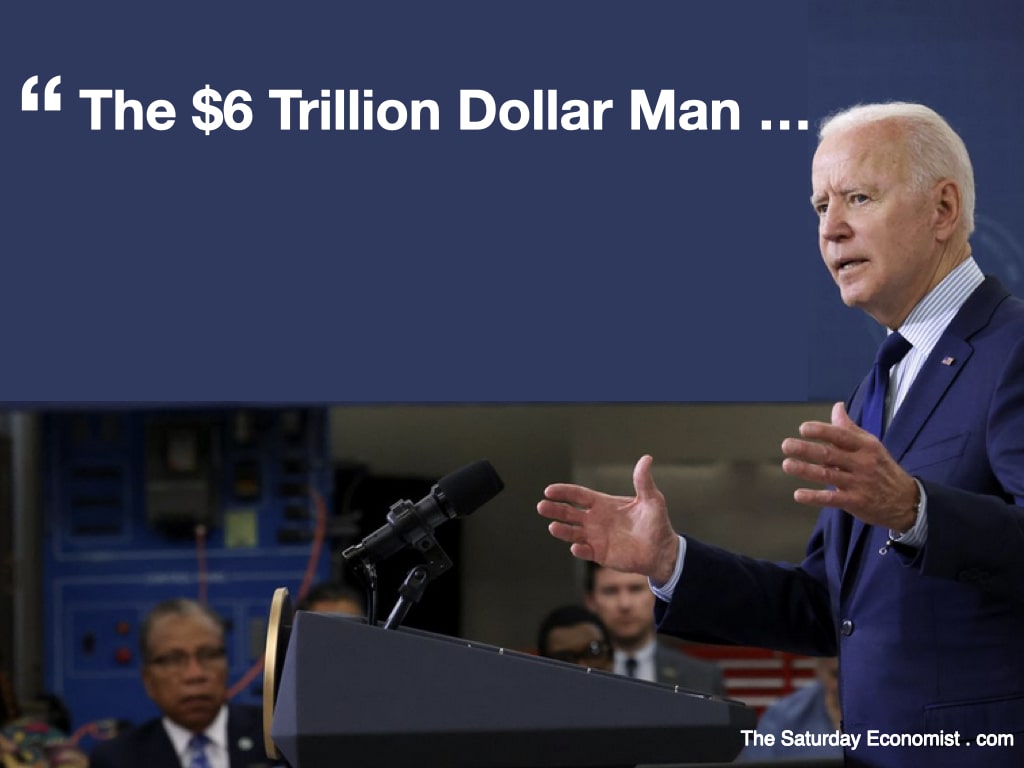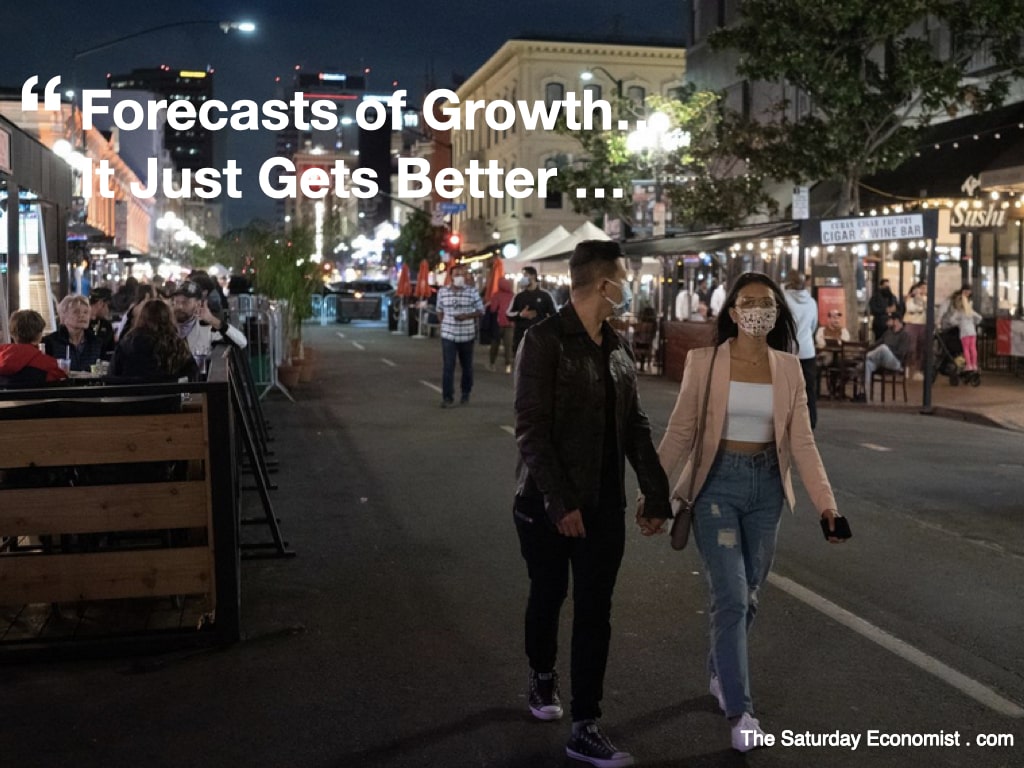|
Where does the money come from ...
Focus on the U.S. This week. Joe Biden announced his £6 trillion dollar budget. The President is committed to an expansion of support for infrastructure, education and the social safety net. Questions are asked, "Where does the money come from?" "Do budget deficits matter any more?" "What will happen to inflation?" Is there a risk of hyperinflation" "Will Interest rates have to rise?" The President's budget forecasts a $1.8 trillion deficit in the fiscal year 2022, followed by a $1.3 trillion deficit in subsequent years. This follows a $3.7 trillion deficit in fiscal 2021. The good news, the deficit is falling as a percentage of GDP from 17% this year to 8% next, then falling further in subsequent years. $10 trillion dollars will have been added to the U.S. debt pile over a period of five years. Where does the money come from? The Fed has been ready to step in as the buyer of last resort. Modern Monetary Financing of the fiscal deficit ensures the Fed will continue to mop up new issuance, at the rate of $120 billion per month. The Fed balance sheet has expanded from $4.2 trillion at the beginning of January last year, to $7.4 trillion by the end of December 2021. A $10 trillion dollar balance sheet is within reach in 2022. Where does the money come from? "We print it digitally" explains the Chairman of the Federal Reserve Jerome Powell in The Saturday Economist Live episode this month. Domestic markets are happy to accept the increase in dollar reserves and money supply. US bond yields hold steady at 1.6%. Foreign exchanges are a little more circumspect about the prospects for the Greenback. Federal debt will increase to 110% of GDP this year. It is set to rise to almost 120% by the end of the decade. Sterling continues to test the $1.42 level. Some expect the move to $1.49 by the end of the year. Growth expectations rise for the year ... Stronger growth could help.The US administration is forecasting growth of 5.2% this year and 3.2% next. The IMF is forecasting growth of 6.5% this year. The latest IHS Markit US Composite index hit 68 in April, that's a series high. Businesses reported an unprecedented expansion in activity in services and in manufacturing. US growth may well exceed 7% this year, assuming firms can secure staff and supplies to support the recovery. Prices are rising. The Bureau of Economic Analysis released the latest personal consumption inflation measure for April. It came in ahead of expectations at 3.6%. It was the strongest reading in 13 years. Not sure what the fuss is about, CPI inflation hit 4.2% in the same month. The pick up in inflation is happening as the rebound in demand meets supply shortages. Output is slow to return to pre-pandemic levels. Prices are squeezed higher. Basing effects are evident. Prices collapsed in April last year. Oil prices WTI basis traded at $16 dollars a barrel. In one week, traders were paid $35 dollars just to roll the barrels away. Inflation is always and everywhere a transitory phenomenon. The Fed is prepared to look through the short term blip in prices, avoiding "tapering" and an increase in base rates to secure first, a return to full employment. Not all are convinced. Former Treasury Secretary Lawrence Summers thinks President Biden’s budget risks overheating the U.S. economy. Summers said Biden is right to be trying to fix infrastructure and reduce inequality but he is worried by the large budget deficits. “I am worried in both the short and medium term about overheating.” The President's tax plan may ease fears on that score. Higher rate tax payers will pay part of the price, the top rate of capital gains tax will rise to 40% in the Biden plan. Either way, for prices this is not a return to high inflation of the 1970s when the collapse of the Peruvian anchovy crop led to hyper-inflation around the world. OK the quadrupling of oil prices didn't help. Today's inflation is transitory and transient. It's due to bottle necks, excessive commodity speculation and a manufacturing diet of "Chips With Everything. The best cure for rising prices is rising prices ... That's all for this week, we will be back with more next week, stay safe ... John
0 Comments
Spend! Spend! Spend! The Shoppers are Back ... Driving Recovery
Retail sales jumped by over 9% in April as masked shoppers returned to the high street. Sales were up 40% compared to April last year. Sales were up by 12% compared to pre-pandemic levels in the months of 2019. Clothing stores were major beneficiaries. Sales volumes increased by 70% compared to prior month. Household goods sales jumped 10%. Furniture sales leapt by 30% as showrooms reopened. Electricals were up by 29%. Sales of cosmetics were up by 25%. DIY and garden centre sales were down. Shoppers had other things on their mind as the high street moved back into business. Salvation for the high street? More of a respite perhaps. Online sales increased by 32% year on year. Clothing sales were up by over 80% year on year. Household goods sales were up by almost 30%. As a proportion of all retail sales, online slipped to 30% of all retail. This was in line with our 30% forecast for the second quarter, as more options open for retail traffic. Fastest Output Growth for Twenty Years ... Business activity is expanding at the fastest rate since records began according to the latest PMI® data compiled by IHS Markit and CIPS. The composite output index increased to 62.0 compared to 60.7 last month. The manufacturing index increased to 63.2. The service sector index increased to 61.8. This all bodes well for a strong recovery this year. Chris Williamson, Chief Business Economist at IHS Markit, said "The UK is enjoying an unprecedented growth spurt as the economy reopens. Factory orders are surging at a record pace as global demand continues to revive. The service sector is reporting near record growth as the opening up of the economy allows more businesses to trade. Business confidence has hit an all time high as concerns about the impact of the pandemic continue to fade. The strongest upturns in demand were reported for hotels, restaurants and other consumer facing services. The output and order book growth seen in May, and the record level of business optimism, are consistent with GDP rising sharply in the second quarter, he said Growth expectations rise for the year ... Growth expectations have been revised up according to the latest forecasts for the UK economy published by HM Treasury this month. The average forecast for GDP growth is now 6.4% compared to 5.3% last month. Growth in 2022 is expected to slow slightly to 5.7% compared to 5.3% last month. The American banks lead the pack. Goldman Sachs forecast growth of 8.1%. JP Morgan forecast growth of 7.9%. The Bank of England now expects growth of 7.25% in 2021. For the moment economists appear to be pretty relaxed about the prospects for inflation. CPI inflation is expected to average 2.2% in the final quarter and through most of the following year. The unemployment rate is expected to fall to 5.2% by the end of 2022. The Saturday Economist Live ... Want to know more? We will be talking about growth, jobs and inflation at The Saturday Economist Live on zoom, Thursday next week. Almost 200 have already signed up. You can do so today ... We are very excited about the format ... fast moving, content rich and fun! We will be talking about What's next for crypto with some great clips of Elon Musk, the "Father of Dogecoin" on Saturday Night Live ... Don't miss that. That's all for this week, I look forward to seeing you on Thursday, Stay Safe, John Andy Haldane Chief Economist of The Bank of England was writing in the Daily Mail this week. "A year from now, it is realistic to expect growth to be in 'double digits' such will be the tennis ball bounce in the UK economy".
The Bank of England is forecasting growth of over 7% this year. That's already a stretch. Ten per cent plus growth next year would be pure fantasy land special. Economists are beginning to talk of an economy in double figures but more for inflation than GDP expansion. CPI inflation hit 4.2% in the USA in April. Producer prices hit 6.8% in China, 6.2% in the USA and 5.9% in the UK, with more to come in next weeks UK data. In the UK our inflation cost models suggest inflation will move to 2.5% real soon. Our monetary models suggest inflation will rise to 4.0% next year. Central banks risk falling behind the curve in the pressure to increase rates. Not least in the UK were retail spending is now above pre Covid levels. Restaurant and pub bookings are recovering rapidly. The housing market is currently "going gangbusters" [Haldane]. Households have accumulated almost £200 billion of forced savings, boosting consumer confidence and encouraging spenders to splash the cash. Asset prices, housing and cryptos appear to be the major beneficiaries. The UK data for Q1 was released this week ... The UK data for Q1 was released this week. Year on year output fell by around 5% compared to last year. In March, manufacturing output was up 5%, construction output was up 6%. Retail distribution was up 7%. The rally in the service sector will continue as accommodation, food, arts, entertainment and leisure sectors come on stream. For the year as a whole we expect growth of 6% this year. This may well be upgraded following the release of the more complete national accounts data next month. A closer look at US Inflation ... US inflation CPI basis hit 4.2% in April very much above forecast expectations. Markets took the hit, bond yields moved higher. Gold moved up. Cryptos moved lower. Elon Musk expressed concerns about the green credentials of Crypto mining. Within the US data, much was made of the hike in second hand car prices, up by 20%. Really it was a story about oil. Gasolene prices and energy costs were up by almost 50% compared to last year. No surprise really. In April last year, Oil prices WTI basis were down at just $16.55 dollars compared to $62 dollars this year. On the 20th April 2020 traders were paid $38 dollars per barrel just to roll the surplus oil stocks away. The oil shock will ease through the rest of the year.This is one of the many reasons the Fed considers the inflation spike to be transitory. Want to know more? Check out and download the TSE Cub articles on our new Flipsnack Channel. Where next for oil prices? and The TSE Forecast Update available on the TSE Club Book Shelf. The Bank of England revised up its forecast for the UK economy this week. Growth of 7.25% is expected in the current year. In February growth of just 5% was anticipated.
The success of the vaccine program, pent up demand amongst households, gross savings and the extension of measures to protect jobs and businesses, improved the outlook for the current year. Growth is expected to slow to 5.75% next year. Over the two years, the bank is forecasting growth of 13% compared to 12.25% last time. It is the shape of recovery, rather than the quantum of recovery, providing the major difference. The bank expects inflation to move above target and hit the 2.5% CPI level later this year. This is largely due to rising energy prices and the comparison effects of price falls recorded last year. Thereafter inflation is expected to return to target as domestic demand and the comparison effect of energy costs from 2020 impacts on producer and retail prices. "Transitory" is the new word in the central bank inflation vocabulary. Both the Fed in the US and the Bank in the UK are keen to see through any short term "drift" above the inflation target. Maintaining an accomodative stance for monetary policy is the priority. The Bank held rates and maintained the asset purchase plan in place for the moment. Want to know more? Check out and download the TSE Cub articles on our new Flipsnack Channel. Where next for oil prices? and The TSE Forecast Update are available on the TSE Club Book Shelf. We are making this channel available to all readers until the end of the month. Sign Up and Join me in The Saturday Economist Club to stay in the loop. You can do so on the TSE Club Page . The Economy is Hotting Up ... The bank forecast for jobs is pretty optimistic. The unemployment rate is expected to hold at the 5% level this year before easing to 4% over the next two years. We outline our views in the TSE Club special. The outlook for jobs and inflation appears to be "transitory". Expect revisions. This week the latest PMI data suggested the economy is hotting up. The manufacturing index increased to 60.9, the service sector index hit 61.0 and the construction index eased to 61.6. What does this all mean? We examine the details in our monthly TSE Club PMI Monthly Review, out next week So what does this mean for inflation? Commodity prices are rising. Copper soared to an all time high this week. Futures rose above $10,000 dollars. Iron Ore prices moved to an all time high. Strong demand from China pushed prices above $200 dollars per tonne. In the UK construction industry costs are accelerating. Timber has increased by 80% in the last six months. Polymer costs are up by 60%. Copper and steel costs have increased by 40% with more price rises to come. Paints and vanishes are up by one third. Monetarists are worried about the surge in liquidity. In the US broad money M2 increased by 24%. In the UK M4 money increased by 12.5%. Soon it will be time to worry about what happens next after what happens next. It could be sooner than you think. Don't worry about inflation, it could be hyperinflation we should be worrying about. We will cover this and more at the next Saturday Economist Live episode on Thursday 27th May at 9:00 am. Don't Miss that ... Fast moving, content rich and fun ... and slightly controversial ... of course ... That's all for this week .. we will be back with more next week. Sign up for The Saturday Economist Club Join the Club Don't Miss Out. John Forecasts of growth in the UK are being revised up. The EY ITEM Club joined the 6% club last month, projecting growth of 6.8% this year. Bloomberg and JP Morgan revised growth forecasts to 7%. The latest estimate from Goldman Sachs suggests growth of 7.8% is possible, outpacing the USA in 2021.
Uncle Sam's shop grew at an annualized rate of 6.4% in the first quarter, according to the Bureau of Economic Affairs. The U.S. is on track to exceed the IMF forecasts made in April of 6.4% growth. The Federal Reserve upgraded its view of the US economic recovery this week. Officials noted an improvement in the economy and offered a brighter picture in the short term. "Amid progress on vaccinations and strong policy support, indicators of economic activity and employment have strengthened," the FOMC said. Hardly surprising, US household incomes increased by 21% in April as Uncle Joe's stimulus checks dropped through the letterbox. The checks will help to fuel the economic revival. Savings rates leapt to 28% in March. Forced savings during the pandemic, suggest consumer spending is set to soar, supporting the recovery. In Europe ... In the EU, growth fell by -1.7% in the first quarter. Spain and Portugal were the most badly hit, with growth down by -4.3% and -5.4% respectively. The Italian economy was down by 1.4%. Just France and Lithuania were in growth territory. The French economy increased growth, up by 1.5%. The IMF forecasts growth of 4.4% in the EU area this year following a setback of around 6.5% last year. More suspect is the 12.5% growth penciled in for India in the year. This suggests China will emerge as the fastest growing economy in the world this year at 8.4%. Modern Monetary Policy ... In the USA the Fed maintained the easy monetary stance. The Fedd funds rate remains within a target range of 0% and 0.25%. The asset purchase program is set to continue as $120 billion dollars per month. The Fed has set a high bar before the removal of any stimulus is imminent. "Substantial further progress will have to be made toward the goals of full employment". Inflation may rise above target in the short term but this is a result of "transitory factors" which will drop out of the system by the end of the year. The Fed continues "Topping up the punch-bowl and handing out the spliffs." Base rates are expected to remain on hold into 2023. So What of Inflation ... In the UK house prices increased by 7.1% in April according to the latest data from Nationwide. Annual growth rates could hit ten per cent by June if prices are flat over the next new months. Inflation CPI remains subdued. Central bank stimulus continues. In the UK Money Supply M4 increased by 12.5%. In the US Money Supply M2 increased by 24%. Will excess liquidity and rising household spending lead to higher inflation? Perhaps! Soon it will be time to worry about what happens next, after what happens next. For the moment forecasts of growth are just getting better and better ... enjoy the what happens next ... That's all for this week .. we will be back with more next week. Our next Saturday Economist Live on Zoom is on Thursday 27th May at 9:00 am. Don't Miss that ... Fast moving, content rich and fun ... and slightly controversial ... of course ... Check out our short trailer and intro to modern monetary policy on our Movie Channel. We explain Q.E. is dead long live Modern Monetary Policy ... My thanks to those who signed up for The Saturday Economist Club this month Join the Club Don't Miss Out. Don't miss our special articles, forecasts and features ... including our May inflation outlook out next week. John |
The Saturday EconomistAuthorJohn Ashcroft publishes the Saturday Economist. Join the mailing list for updates on the UK and World Economy. Archives
July 2024
Categories
All
|
| The Saturday Economist |
The material is based upon information which we consider to be reliable but we do not represent that it is accurate or complete and it should not be relied upon as such. We accept no liability for errors, or omissions of opinion or fact. In particular, no reliance should be placed on the comments on trends in financial markets. The presentation should not be construed as the giving of investment advice.
|
The Saturday Economist, weekly updates on the UK economy.
Sign Up Now! Stay Up To Date! | Privacy Policy | Terms and Conditions | |





 RSS Feed
RSS Feed